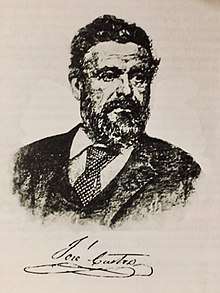José Castro
| José Castro | |
|---|---|
 | |
|
In office 1835–1835 | |
| Appointed by | José Figueroa |
| Preceded by | José Figueroa |
| Succeeded by | Nicolas Gutierrez |
(self-declared after coup) | |
|
In office 1836–1836 | |
| Governor of Baja California | |
|
In office 1853–1860 | |
| Personal details | |
| Born |
1808 Monterey, California |
| Died | February 1860 |
| Profession | Soldier |
| Military service | |
| Allegiance |
|
| Service/branch |
|
| Rank |
|
| Battles/wars |
Battle of Providencia Revolution of 1836 |
José Antonio Castro (1808 – February 1860) was a Californio politician, statesmen, and military leader who served as acting governor of Alta California in 1835.[1] He was also Commandante General of Mexican forces in northern areas of Las Californias during the Bear Flag Revolt and the Mexican-American War of 1846-1848.
Biography
José Castro was a Californio, born in Monterey, California when it was under Spanish colonial rule. His father José Tiburcio Castro was a soldier, member of the Diputación (territorial legislature), mayordomo (administrator) of Mission San Juan Bautista after it was secularized, and grantee of Rancho Sausal.
As a young man, Castro was a vocal and active supporter of Californian self-rule and semi-independence from Mexico.[2] His first public office was as secretary to the Monterey ayuntamiento (town council). In 1830, Castro was arrested for his opposition to the Mexican governor of Alta California. By 1835 he was Vocal Primero (First Member) of the legislature and acting governor. Along with his brother-in-law Juan Bautista Alvarado, he was a vocal proponent of California-born governors and sought a semi-independent status for Alta California.[3]
After the Siete Leyes reforms of 1836 increased central government control of California, Castro helped lead the overthrow of newly-appointed Mexican Governor Nicolás Gutiérrez,[3] becoming first president of the declared independent California. Castro and Alvarado, however, failed to convince southern California leaders to join them, and the coup failed. The coup leaders did, however, escape prosecution. and then Commandante General.
Under his brother-in-law, Governor Alvarado, Mariano Guadalupe Vallejo became Commandante General in 1837-38, and Castro became Lieutenant-Colonel of militia. Once again he was appointed First Member of the Diputación as well as Prefect of the District of Monterey. In 1839, Alvarado granted him Rancho San Justo, which included the settlement surrounding Mission San Juan Bautista. The grant followed the secularization of the mission by the Mexican government in 1833, which privatized former mission lands. Castro built an adobe house on San Juan Bautista Plaza in 1841. He used the house as an administrative base for his military operations, and as a residence for his secretary.[2]
Back in 1840, Alvarado had arrested about one hundred Americans in California and transported them to San Blas, an action that sparked an international diplomatic incident known as the "Graham Affair". By 1844-45, Castro was a leader of the new revolt against Governor Manuel Micheltorena, once again becoming Commandante General of California.[3]
During the Bear Flag Revolt of 1846 and Mexican-American War that followed, Castro was the commanding general of Alta California. When California joined the United States in August of 1846, Castro left for Baja California, taking up residence in Sinaloa. Castro returned to Alta California in 1848, but by 1853 had gone to Mexico again where he was appointed governor and military commander of Baja California.[4]
After the U.S.-Mexican War, José Castro opened his adobe house in San Juan Bautista to an Irish settler, Patrick Breen. Breen and his family were surviving members of the Donner Party. They arrived at San Juan Bautista in February 1848, nearly a year after completing their journey through the Sierra Nevada. The Breens were the first English-speaking Americans to live in the town. Castro allowed them to live at the house until they could afford to buy it from him.[2] By 1853, Castro had left for Mexico, where he was appointed governor and military commander of Baja California.[2]
One of Patrick Breen’s teenage sons made a fortune as a gold miner and purchased the house from Castro in 1854. The Breen family established a working ranch and an inn. Guests included gold rush prospectors and Helen Hunt Jackson author of Ramona (1884). She began writing her famous novel about Spanish California while living in San Juan Bautista in the early 1880s.[2] The Breen family owned the house until 1935, when the State of California bought the property and it became part of the San Juan Bautista Plaza Historic District.
Castro never surrendered his Mexican citizenship nor military rank. In February 1860, Castro was assassinated by the bandit Marguez.
Legacy
The Jose Castro House in San Juan Bautista is now a National Historic Landmark. Castro Street and the Castro District in San Francisco are named for him.
References
- ↑ Killea; Lucy Lytle (October 1966). "Journal of San Diego History". San Diego Historical Society. sandiegohistory.org. Archived from the original on April 22, 2005. Retrieved 16 June 2010.
- 1 2 3 4 5 "José Castro House San Juan Bautista, California". U.S. National Park Service. Retrieved 26 August 2016.

- 1 2 3 Grafe, Ernest. "Intrigue and Confrontation; The Castros of California" (PDF). Grafe. egrafe.com. Retrieved 16 June 2010.
- ↑ "California and the Indian Wars, José Antonio Castro, Commandante-General and Acting Governor of Alta California". The California State Military Museum. California State Military Department.
This article incorporates content in the public domain from the U.S. National Park Service and The California State Military Museum.
